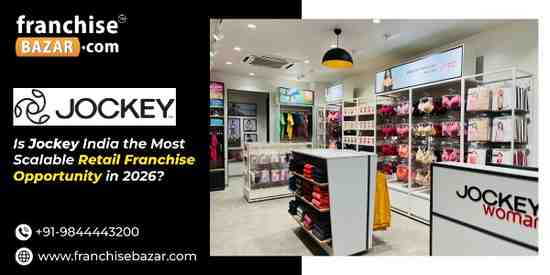How to Invest in Supermarket Retail Without a DMart Franchise in 2026

Written By: Harsh Vardhan Singh
The biggest misconception among new investors entering India’s retail market is simple: “To succeed in supermarket retail, you must own a DMart franchise.”
But here is the truth every serious investor needs to understand in 2026:
DMart does not franchise at all.
Not now, not before, and not in the upcoming decade.
So if you want to enter the booming grocery and supermarket retail industry, the DMart path is not even an option. But the opportunity itself is huge, expanding, and far more accessible than most people imagine.
The right supermarket franchise can give you steady footfall, predictable revenue, fast inventory rotation, high repeat customers, and a stable business model that survives every economic cycle.
This guide breaks down how to enter supermarket retail in 2026 without DMart, which supermarket franchise formats are growing, what investors must know, and how you can build a strong business in this sector.
Everything is written in a short, bullet-friendly, highly readable format to match FranchiseBazaar’s professional expectations.
Why Supermarket Retail Is One of India’s Safest Businesses in 2026
Supermarkets are growing because India’s consumption habits are changing faster than ever.
The demand is constant, essential, and recession proof.
Key reasons supermarket franchise demand is booming:
- Customers now prefer organised retail
- People want clean, hygienic, branded stores
- Daily groceries guarantee repeat business
- Urban and tier two growth is driving volume
- Digital payments and UPI have made shopping seamless
- Home delivery and subscription models increase customer stickiness
- Rising disposable income is pushing premium grocery categories
- FMCG companies prefer supplying to organised chains
Supermarkets do not rely on trends.
Customers buy groceries regardless of the economy, making a supermarket franchise a highly stable business.
Why You Cannot Get a DMart Franchise
DMart is one of the largest retail chains in India, but their model is fully company owned.
They do not offer franchising due to real estate, warehousing, and operational complexity.
Why DMart avoids franchising:
- They want full control over pricing
- They rely heavily on bulk purchasing
- Their profit model depends on owning real estate
- They follow a strict low margin strategy
- They avoid franchise dependency
This means investors must look toward other supermarket franchise brands that actually allow ownership.
Why You Should Still Enter Supermarket Retail Without DMart
Even without DMart, the opportunity remains extremely strong.
India needs thousands of new organised supermarkets in the next five years.
Reasons to enter the industry:
- Untapped tier two and tier three potential
- High consumption of FMCG products
- Online grocery demand strengthening offline stores
- Strong margins on essentials and local brands
- Predictable monthly income
- Repeat footfall from families
- Neighborhood-based loyalty
- Stable business unaffected by seasonal trends
A supermarket franchise offers stability, scale, and longevity that most businesses struggle to match.
Best Supermarket Franchise Entry Paths for 2026
Instead of only one route, franchise owners have several entry options.
Every budget and city zone has a format that fits.
Popular franchise types you can invest in:
- Mini supermarket
- Hyperlocal convenience store
- Mid-range supermarket
- Premium grocery store
- Wholesale club model
- Organic and health-focused supermarket
- Hybrid online plus offline model
Choosing the right supermarket franchise depends on your investment capacity, local competition, and neighborhood demand.
Investing Smartly: How to Choose the Right Supermarket Franchise
This section is crucial because choosing the wrong model causes most failures.
What to evaluate:
- Brand experience
- Franchise support quality
- SKU management system
- Billing and tech ecosystem
- Supply chain reliability
- Margin structure
- Target customer profile
- Local competition
- Break even expectations
- Location footfall
A good supermarket franchise gives you strong backend support, clear store guidelines, effortless billing, and a stable procurement network.
Top Features Customers Expect from Supermarkets in 2026
Modern shoppers expect more than just shelves and billing counters.
Customers prefer supermarkets with:
- Fresh fruits and vegetables
- Clean packaging
- Quick billing
- Digital payments
- Self checkout
- Loyalty points
- Subscription discounts
- On time home delivery
- Attractive racks and displays
- Weekly and monthly offers
A supermarket franchise that meets these expectations automatically enjoys high customer retention.
Investment Required for a Supermarket Franchise in 2026
The cost varies based on format, size, and brand reputation.
Here’s a clear structure investors can use:
Small Format
- Investment range: eight lakh to fifteen lakh
- Ideal for: neighbourhood stores and low rent areas
- Area required: three hundred fifty to six hundred square feet
Medium Format
- Investment range: twenty lakh to forty lakh
- Best fit for: housing clusters and high footfall streets
- Area required: six hundred to one thousand five hundred square feet
Large Format Supermarket
- Investment range: fifty lakh to one crore twenty lakh
- Suitable for: high visibility commercial zones
- Area required: one thousand five hundred to four thousand square feet
Your supermarket franchise cost should match your expected revenue and local demand.
Expected Earnings and ROI for a Supermarket Franchise
Supermarkets generate revenue from rapid inventory turnover.
Margins vary based on product categories and store scale.
Typical income expectations:
- Monthly revenue for small stores: four lakh to eight lakh
- Monthly revenue for medium stores: eight lakh to twenty lakh
- Monthly revenue for large stores: twenty lakh to fifty lakh
Profit margins:
- Average margin: eight percent to fifteen percent
- Higher margins on fresh produce
- Good margins on local brands
- Competitive margins on FMCG essentials
ROI timeline:
- Break even: twelve months to twenty four months
- Highest returns: festival seasons and bulk sales
Supermarkets succeed through consistent volume, not premium markups.
What Makes Supermarket Franchises Different From Other Retail Formats
Supermarkets do not depend on trends or impulse purchases.
They run on essential goods.
Core strengths of supermarket franchises:
- High footfall
- Repeat loyal customers
- Multiple billing counters
- Strong FMCG partnerships
- Year round demand
- Easy to expand
- Community connection
- High cross selling opportunities
A well-run supermarket franchise becomes the backbone of a local neighborhood.
Best Locations for a Supermarket Franchise in 2026
Location determines seventy percent of success.
Best performing locations include:
- Residential clusters
- Near gated societies
- Near corporate parks
- Railway station zones
- High density rental neighborhoods
- Near colleges and coaching hubs
- Tier two city centers
- Market areas with low organised competition
The right supermarket franchise thrives in places where families visit repeatedly.
Mistakes Investors Make When Entering Supermarket Retail
Avoiding these mistakes can save lakhs.
Common errors:
- Over stocking
- Poor SKU planning
- Wrong pricing strategy
- Weak store layout
- No loyalty program
- Lack of local marketing
- Hiring untrained staff
- Choosing a poor location
- Ignoring customer complaints
- Not tracking waste and expiry
A systematic supermarket franchise solves most of these issues with SOPs and training.
Why 2026 Is the Best Year to Enter the Supermarket Franchise Sector
India’s consumption growth is reaching its strongest phase.
Reasons 2026 is the right year:
- Tier two and tier three cities are expanding
- Families are shifting from kirana to organised grocery
- Better supply chain systems are available
- Digital payments make billing faster
- Customer loyalty programs are booming
- Online and offline retail is merging
- Private labels are growing
- Food inflation increases basket value
- Real estate rents stabilising in many markets
Supermarket retail in 2026 is not just promising.
It is guaranteed growth for the next decade.
How to Compete With DMart Without Being DMart
Instead of competing head to head, find the gaps DMart cannot fill.
Strengths you can build:
- Smaller neighbourhood stores
- Faster delivery
- Personalised service
- Flexible offers
- Fresh category focus
- Hyperlocal customer engagement
- Higher availability of local brands
A supermarket franchise with community focus can outperform big giants in multiple areas.
What Support You Receive From Most Supermarket Franchises
Support makes the difference between success and failure.
Franchise support usually includes:
- Store setup guidelines
- Branding and interior design
- SKU planning
- Billing software
- Supplier connections
- Onboarding and training
- Inventory management support
- Launch marketing
- Festival season promotion kits
- Delivery integration assistance
This support system helps first time business owners operate professionally.
Final Takeaway: Should You Invest in a Supermarket Franchise in 2026
If you want a business that offers:
- Daily footfall
- High repeat customers
- Multiple income streams
- Stable yearly revenue
- Fast inventory rotation
- Strong local presence
- Long business life
- Low failure rate
- High relevance in every economy
Then investing in a supermarket franchise in 2026 is one of the smartest decisions you can make.
Supermarkets do not depend on trends or hype.
They depend on everyday human needs.
Entering this industry without a DMart franchise is not a limitation.
It is actually an opportunity.
Because the future of Indian retail belongs to entrepreneurs who understand neighbourhood convenience, organised shopping, and the power of a good supermarket franchise.
Disclaimer: The brands mentioned in this blog are the recommendations provided by the author. FranchiseBAZAR does not claim to work with these brands / represent them / or are associated with them in any manner. Investors and prospective franchisees are to do their own due diligence before investing in any franchise business at their own risk and discretion. FranchiseBAZAR or its Directors disclaim any liability or risks arising out of any transactions that may take place due to the information provided in this blog. For more such opportunities, visit us on our Insta and FB
Recent Blogs

Written By: Khushboo Verma
India’s...

Written By: Harsh Vardhan Singh
The biggest...

Written By: Gouri Ghosh
Every parcel in India...

Written By: Bandana Gupta
India’s...
Why Should I Register?
You are seeking to access information which is provided only to registered members. It takes less than a minute to register and access information on FRANCHISEBAZAR.